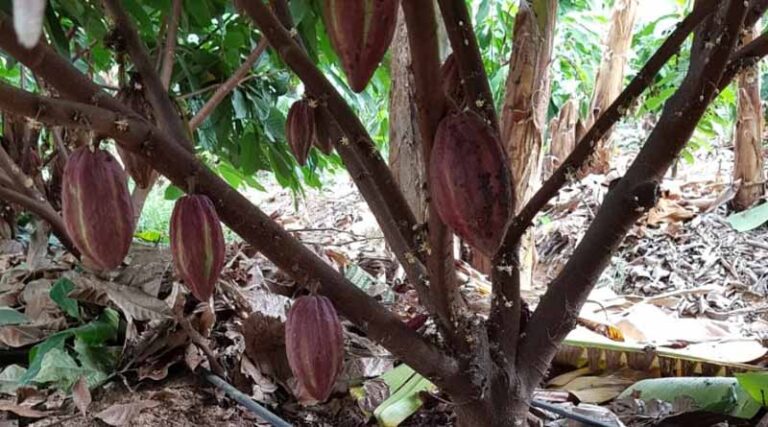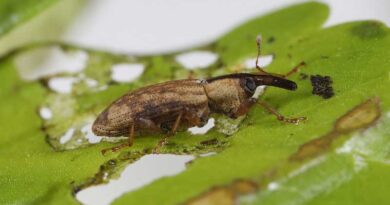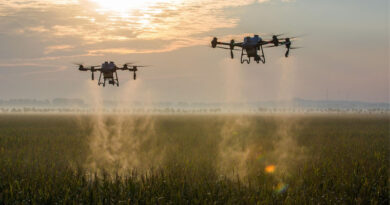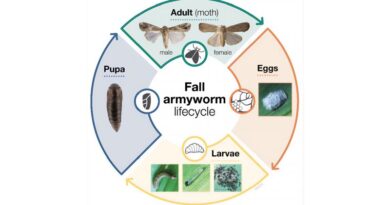
Global Cocoa Production Crisis Opens New Opportunities for Brazil
10 September 2025, Brazil: With proper management and the use of technologies like drip irrigation, the state of Ceará is accelerating the revival of cocoa cultivation in Brazil and gaining prominence, potentially boosting Brazilian producers on the international stage.
Easter 2025 was one of the most expensive (and bitter) in recent years due to the sharp rise in the price of cocoa, the main raw material for chocolate, in the international market. According to the International Cocoa Organization (ICCO), compared to the start of the 2024/25 season, prices increased by 66% in London, rising from US$6,896 per ton on October 1, 2024, to US$11,441/ton on December 31, 2024. In New York, the increase was 64% over the same period, from US$7,061/ton to US$11,545/ton.
One of the main reasons for this surge is the decline in global supply. Côte d’Ivoire and Ghana, the world’s two largest cocoa producers, are facing challenges that contribute to the crisis. Extreme weather events, increased infestation by the CSSV (Cacao Swollen Shoot Virus), and aging, low-yielding plantations are among the key factors that, combined, led to the current situation.
As this scenario is unlikely to be resolved in the short to medium term, Brazil is presented with a new opportunity amid the cocoa supply crisis: the chance to reclaim its former prominence using technologies like localized irrigation in a crop that, from the 1930s to the 1980s, was a symbol of wealth, but which suffered one of the biggest phytosanitary disasters in Brazilian agriculture.
A Tragic Turning Point
The “Witches’ Broom” disease profoundly changed the history of cocoa in Brazil, especially in Bahia, which was once one of the largest cocoa-producing regions in the world. The disease officially appeared in 1989. The pathogen—a fungus called Moniliophthora perniciosa—was likely native to the Amazon region but was introduced to Bahia under suspicious and criminal circumstances, according to investigations at the time.
The outbreak worsened quickly, and Brazil lost about 70% of its cocoa production in Bahia in under a decade—dropping from nearly 400,000 tons per year to 123,000 tons per year by the 2000s. Thousands of farmers went bankrupt. “Witches’ Broom practically ended cocoa production in Brazil, especially in Bahia and the Amazon, and caused a social and environmental collapse that still resonates today,” said agronomist Adolfo Moura, who has been working for over ten years developing productive clones adapted to the Northeast.
Now, 35 years later, Brazil has the opportunity to rewrite this history and shift from a supporting role to a global leader in cocoa production, with technology as the driving force of this new chapter. “With the global production shortfall, Brazil has a chance to meet this demand. However, domestic cultivation is still modest, and we need to expand planted areas to first meet high domestic demand, then consider exports,” Moura emphasized.
Irrigation as a Game-Changer
The adoption of irrigation technologies, especially drip systems, will play a crucial role in the future of cocoa farming in Brazil. This technique allows precise delivery of water and nutrients directly to the root zone, minimizing evaporation losses (with efficiency above 90%) and increasing productivity by up to 150% compared to non-irrigated systems, according to FAO and World Cocoa Foundation data.
Thanks to solutions like those from Rivulis, full-sun cultivation—previously unfeasible in many regions—has become a reality. Young plants can be irrigated with 2 to 5 liters per plant per day, while mature trees require 20 to 40 liters per day, depending on phenological stage and weather. Fertigation also enables the regular supply of micronutrients such as zinc, iron, boron, and magnesium, optimizing plant performance and nutrient uptake.
In irrigated areas with intensive management, yields can exceed 2,000 kg/ha/year, reducing unproductive cycles and increasing harvest uniformity. This is nearly four times the average seen in many African countries, significantly increasing farmer income and making cultivation economically viable in previously marginalized areas.
Ceará Cocoa Is Already a Reality
One of the regions that embraced cocoa cultivation is Ceará. The main initiative began in 2010 through a mutual cooperation project led by the Univale Association, supported by producer João Teixeira Junior of Frutacor, CEPLAC (Executive Commission for the Cocoa Farming Plan) under the Ministry of Agriculture, and Embrapa.
The project was led by agronomist and irrigation specialist Diógenes Henrique Abrantes Sarmento, with the goal of introducing alternative crops in the drought-prone Jaguaribe Valley region. “I was hired to coordinate the research, and we tested cocoa, persimmon, apple, and pear across different areas of the state. After years of trials, cocoa proved to be the best adapted crop,” said Sarmento.
Encouraged by cocoa’s strong performance, the first 4-hectare plot was established in 2010 with 12 Brazilian-adapted clones. Among these, CCN51 and PS319 stood out with average yields between 2.5 and 3 tons per hectare—much higher than traditional regions, which barely reached 900 kg/ha. “This result confirmed the crop’s potential here. Alongside high-quality clones, we used good soil management and careful practices from pre-planting to post-harvest. Coupled with localized irrigation, high production became possible even under Ceará’s intense heat and sun,” Sarmento said.
The Role of Irrigation
As cocoa farming moves to hotter, drier regions in Brazil, irrigation has become essential. Drip irrigation has proven to be the foundation of the new production model, offering precise water and nutrient control that results in healthier plants, more uniform crops, and more efficient use of natural resources.
According to Carlos Barh, an agronomist with over 50 years of irrigation experience and currently with Rivulis in technical customer support, drip irrigation is ideally suited for cocoa. “Cocoa was made for drip irrigation—it prevents excess moisture that could lead to fungal development. The plant stays healthier because technologies like Rivulis’ systems deliver water exactly when and where it’s needed,” he said.
Barh also highlighted the importance of fertigation. “A plant can’t survive without water, but water alone isn’t enough. That’s why it’s critical to provide the right nutrients at the right time. It’s extremely efficient—nutrient losses are minimal and the plant responds with higher yields and quality,” he added.
Logistical Challenges
After identifying the most efficient clones, best irrigation methods, and ideal crop and soil management techniques, the next challenge for Ceará’s cocoa was logistics—how to transport production to the main industries located in Bahia, which was complex and costly.
Given the high quality of the beans, Sarmento and his team decided to vertically integrate. “We realized our beans were fine-grade and ideal for chocolate and cocoa butter production. So in 2018, we founded Cacau do Ceará in Limoeiro do Norte—the first local industry to use cocoa exclusively from state producers,” the agronomist recalled.
With a local industry in place, the initial 4-hectare area expanded. Studies also showed that other crops could be intercropped with cocoa, creating new income sources. Coconut and banana were added to the mix.
From there, the project took off. More than 300 hectares are now cultivated by producers who joined the movement. “We began large-scale planting and focused on adding value so that final products would be ready for market, both in Ceará and across Brazil—not only chocolate but also other cocoa byproducts,” said Sarmento.
Operating since May 2021, the industrial plant is already expanding, with production capacity expected to grow from 100 kg to 1 ton per month. “Cocoa is now a reality in Ceará. There’s strong demand from producers and the industry. Our goal is to exceed 400 hectares planted in the region by January,” the agronomist added.
Future Potential and Opportunities
Thanks to the high-quality clones now used, cocoa has the potential to expand across Ceará and other regions of the Northeast, Midwest, and even Southeast Brazil. According to Sarmento, cocoa cultivation requires little labor—which is scarce in Brazil—and can be planted during hot periods and easily intercropped, making it ideal for all types of producers.
He also pointed out the crop’s high profitability. “With good management, even small areas can yield around 3,000 kg of beans per hectare. At an average of R$50/kg, that’s R$150,000 gross income, with production costs around R$22,000—leaving a significant profit margin,” he explained.
To scale up production, the cocoa sector is now seeking public-private partnerships to support research and expand cultivation in various parts of Brazil. Reliable production and yield data, as well as access to financing and credit lines from banks, are essential. “We also need training programs to improve labor quality and crop management, create local consultants, and develop more nursery operators to reduce the wait for new seedlings,” Sarmento concluded.
Also Read: DialogueNEXT India: 60 Years of Borlaug’s Legacy, Global Leaders Convene to Confront Hunger
📢 If You’re in Agriculture, Make Sure the Right People Hear Your Story.
From product launches to strategic announcements, Global Agriculture offers unmatched visibility across international agri-business markets. Connect with us at pr@global-agriculture.com to explore editorial and advertising opportunities that reach the right audience, worldwide.






